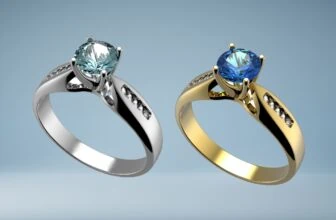
Table of Contents
Moonstone, found worldwide, mesmerizes with its dreamy blue to white glow, reminiscent of moonbeams. Its fragility calls for tender care, yet its distinct shimmer makes it a sought-after gem for jewelry, particularly as an alternative birthstone for June.
If you’re considering adding moonstone jewelry to your collection, we’ve got you covered. Here’s everything you need to know about this stunning gemstone and its use in jewelry.

What is a Moonstone?
Moonstone, with its ethereal glow, is more than just another pretty gem. What makes it truly stand out is the unique sheen that appears to dance on its surface, all thanks to its physical makeup. At its core, a moonstone is the beautiful combination of two feldspar minerals: orthoclase and albite. These minerals separate into distinct layers, and when light graces the stone, it scatters amongst these layers. This scattering effect births the phenomenon called “adularescence.”
At a glance, adularescence might appear as an internal light show or soft, wispy clouds moving just beneath the stone’s surface. This captivating sheen seems to give moonstone its very own heartbeat of light. While other gemstones can also boast of their own adularescence, moonstone often showcases it most vividly.

But that’s not where moonstone’s magic ends. There’s another optical wonder it holds: chatoyancy. Commonly known as the ‘cat’s eye effect,’ chatoyancy presents itself as a striking band of light spanning the stone, reminiscent of, well, a cat’s eye.
Moonstone’s allure isn’t just limited to its appearance. Take, for example, the Moonstone Ring by Minimal VS. It’s a testament to how this gem can transform a simple piece of jewelry into something mesmerizing.
In essence, moonstone is a gem that promises enchantment, be it through its unique sheen or its mysterious cat’s eye effect.
The 4 C’s of Moonstone: Color

Moonstone offers a spectrum of hues, ranging from pink, peach, and green to white, brown, and gray. Among these, the blue moonstone stands out as the most exquisite and sought-after shade. The blue sheen at the center of the stone, particularly when it covers a wider area, is especially prized by buyers.
Additionally, moonstones that exhibit adularescence—a captivating play-of-light—are also highly valued, enhancing the gem’s overall appearance and the perception of its color.
The 4 C’s of Moonstone: Clarity

Clarity is a critical factor in determining the moonstone’s value. Clearer stones without inclusions are naturally more valuable. Some moonstones might contain tiny tension cracks called “centipedes“, which can mar the stone’s beauty by disrupting its adularescence.
The highest priced moonstones are typically those that are free from centipedes or any unattractive greenish tints.
The 4 C’s of Moonstone: Cut

Moonstones are commonly cut into beads, and cabochons, or are faceted.
The best cut for moonstone is cabochon, as it emphasizes adularescence. However, faceting is becoming increasingly popular for moonstones, as this can hide any inclusions in the stone.
One of the most popular cuts for moonstones is the rose cut, which highlights the color and texture of the stone, adding depth and angle.
Moonstones can also be carved and were sometimes used for cameos or intaglios in the past.
The 4 C’s of Moonstone: Carat Size

Moonstones are available in a variety of sizes. For jewelry crafting, stones ranging from 1 to 5 carats are often favored. However, larger clear stones, particularly those around 15 to 20 carats, are rare treasures. Interestingly, there have been exceptional discoveries, with the largest reported moonstone weighing a staggering 300 to 450 carats!
When considering a moonstone purchase, these four C’s can guide you in selecting a stone that not only matches your aesthetic preferences but also ensures good value for money.
As the center choice for a ring, a moonstone is eye-catching and unique. The cat’s eye effect and the sheen of the stone really make it stand out.
If surrounded by other smaller stones (dark colors work best), the natural color of the moonstone stands out even more.

The moonstone’s popularity as the center stone for engagement rings is increasing. Many non-conventional couples who are trying to break away from the traditional diamond ring would find this a beautiful alternative.
However, before you get too excited, bear in mind that the moonstone has a hardness ranking of only 6.0 to 6.5 on the Mohs scale. This makes it quite a soft stone compared to sapphires or diamonds and would require care and maintenance to prolong its life.
While we don’t recommend moonstones in engagement rings, if set in a protective setting, like a bezel setting or a halo setting, and taken reasonable care of, a moonstone engagement ring can last a lifetime.
How is Moonstone Used in Jewelry?
Moonstones are a popular gemstone in many types of jewelry for both men and women.
They’re commonly set in sterling silver, mixed metals, titanium, or gold and are designed to optimize the natural sheen and cat’s eye effect which add value to the stone.
They work beautifully with other gemstones, and you will often find moonstones in combination with other colored stones.
For those born in June, the moonstone is your birthstone. All the more reason to buy one!
1. Moonstone Pendants

Moonstone pendants are a popular choice in jewelry due to their unique adularescence and versatile color palette. These pendants come in shades from blue to peach, offering a variety of looks suitable for different tastes.
Set in metals like silver or gold, moonstone pendants provide a subtle yet attractive accessory for daily wear or special occasions. Their simple elegance and timeless appeal make them a favorite for many jewelry enthusiasts.
2. Moonstone Earrings

Moonstone earrings match any occasion. You can find studs for casual daily wear. Like pearls, they add a touch of class to any outfit. Long beautiful moonstone earrings dress any outfit up right away!
3. Moonstone Bracelets

You can find bracelets in various designs, some with a large centerpiece moonstone, and others with a string of smaller moonstone beads. They go exceptionally well with all metal colors and look gorgeous for both casual and formal wear.
But if you thought that moonstone is only used in inexpensive costume jewelry, think again. Some of the best designers have worked with moonstone and created stunning collections fit for royalty.
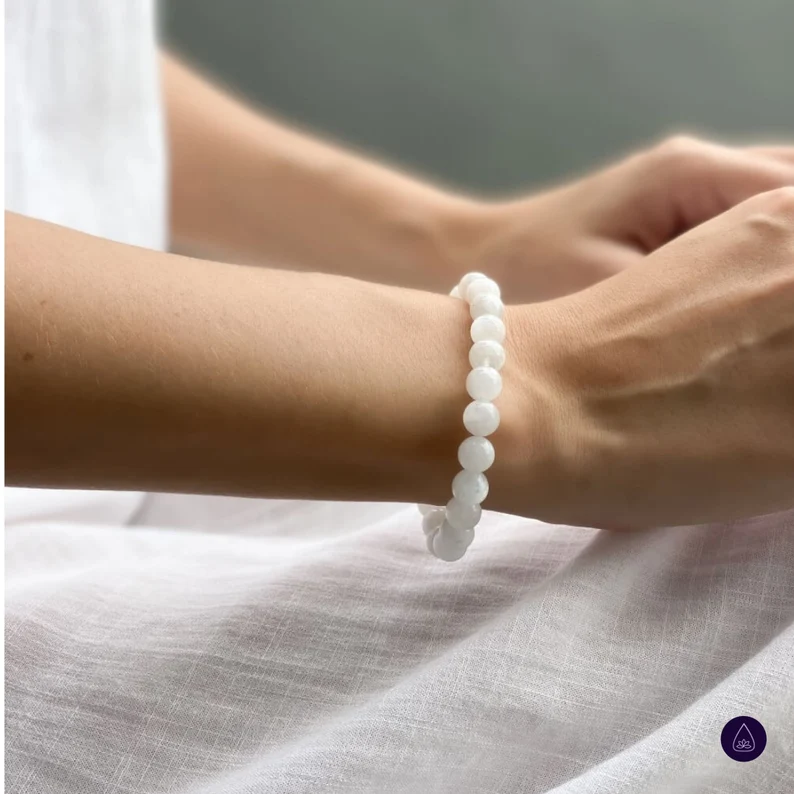
Moonstone beads are often strung together to create beautiful beaded bracelets. Moonstone cabochons or faceted stones can be set in metal to form the centerpiece of bangles or cuff bracelets. Whether combined with other gemstones or used on its own, moonstone offers a versatile and elegant touch to bracelet designs.
54. Moonstone Brooches and Cufflinks
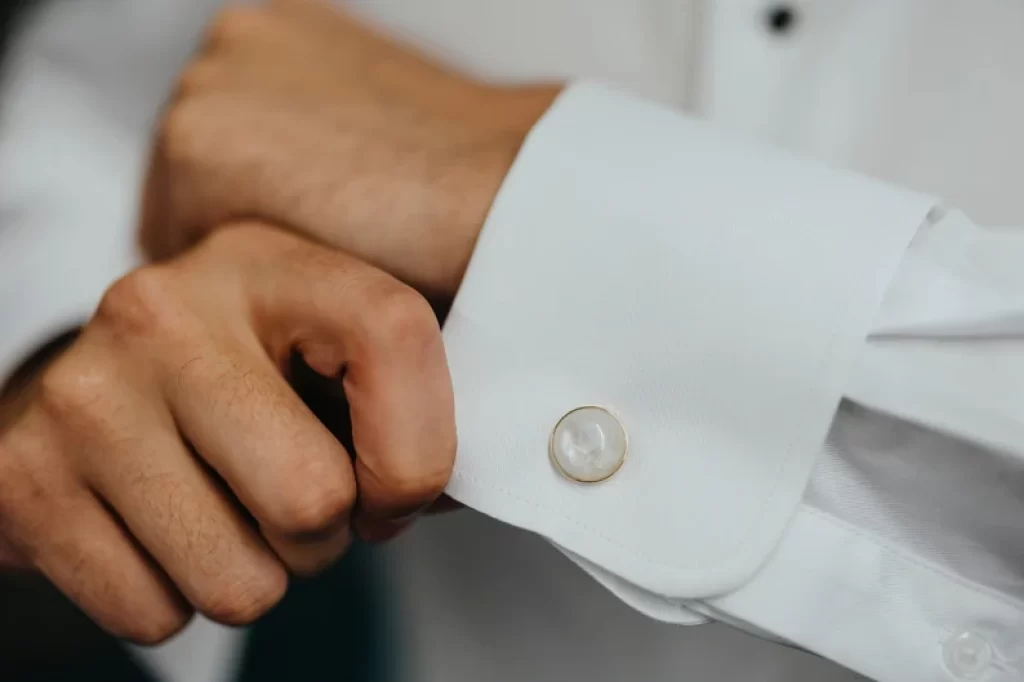
Moonstone brooches and cufflinks offer a classic yet distinctive touch to attire. Brooches featuring moonstone bring out the stone’s ethereal glow, adding elegance to jackets or scarves.
Moonstone cufflinks provide a subtle shimmer to shirt cuffs, elevating formal wear with their unique luminosity. Both accessories highlight moonstone’s timeless appeal in stylish, understated ways.
5. Moonstone Rings

Moonstone is often used in rings, but with a Mohs hardness of 6-6.5, it’s softer than some other gemstones and requires extra care to avoid scratches or damage. It’s best suited for pieces that won’t undergo heavy wear or for those mindful of their jewelry.
Is Moonstone Enhanced or Treated?

Moonstones typically don’t undergo any major treatments or enhancements to improve their appearance. Their mesmerizing adularescence is a natural occurrence. However, like many gemstones, they might occasionally be subjected to basic treatments like heating to improve their clarity or color consistency.
Always inquire about any treatments when purchasing moonstones or any other gemstones. If a moonstone has undergone treatments, reputable dealers will disclose this information to buyers.
History of Moonstone

Moonstone has a long history dating back to ancient times. It was highly revered by various cultures for its mystical and spiritual qualities. In ancient Rome, for example, moonstone was associated with the lunar deity Diana and was believed to possess the power of the moon. It was often used in jewelry and amulets to bring good fortune, protection, and love.
1. Indian Heritage
Moonstone has strong ties to Indian culture. In India, moonstone is considered a sacred and magical gemstone. It’s often used in jewelry, especially in traditional pieces worn during weddings and religious ceremonies. The stone is believed to have connections to various deities and to enhance spiritual growth.
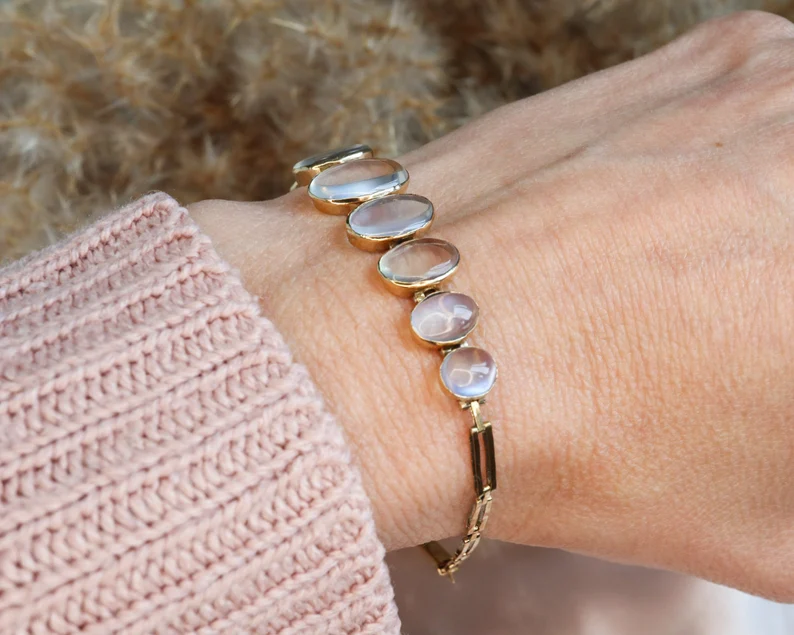
2. Victorian Era Resurgence
Moonstone experienced a resurgence in popularity during the Victorian era in Europe. It was used extensively in jewelry during this time, often set in intricate designs alongside other gemstones. Moonstone’s ethereal appearance aligned well with the romantic and sentimental aesthetics of the era.
3. Art Nouveau Influence
Moonstone also played a role in the Art Nouveau movement, which emerged in the late 19th century. Jewelry designers of this period were drawn to moonstones’ dreamy, mystical qualities, and they incorporated them into their intricate and nature-inspired designs.

4. Modern Popularity
Moonstone’s popularity has continued into modern times. It remains a sought-after gemstone for jewelry, often used in necklaces, rings, earrings, and bracelets. Designers appreciate its unique play of light and its ability to create a soft, elegant glow.
Throughout its history, moonstone has maintained its aura of mystery and enchantment, captivating people with its celestial beauty and spiritual connotations. Whether used for its believed mystical properties or simply admired for its stunning play of light, moonstone continues to be a cherished gemstone in the world of jewelry and spirituality.
Moonstone vs. Opalite

Both moonstone and opalite are known for their enchanting colors and translucent charm, making them appear similar to the untrained eye, which is why one is often mistaken for the other. However, there are stark differences in their origins, makeup, and attributes.
1. Origin & Composition
Moonstone is a naturally occurring gem that is part of the feldspar group. The magical glow it radiates, termed adularescence, is a result of the intricate interaction of two feldspar types: orthoclase and albite. This interaction scatters light within the stone, producing its signature sheen.
Contrarily, opalite is not a product of nature but of craftsmanship. Typically made from glass or resin, its opalescent shine is a testament to the intricacies of the manufacturing process.
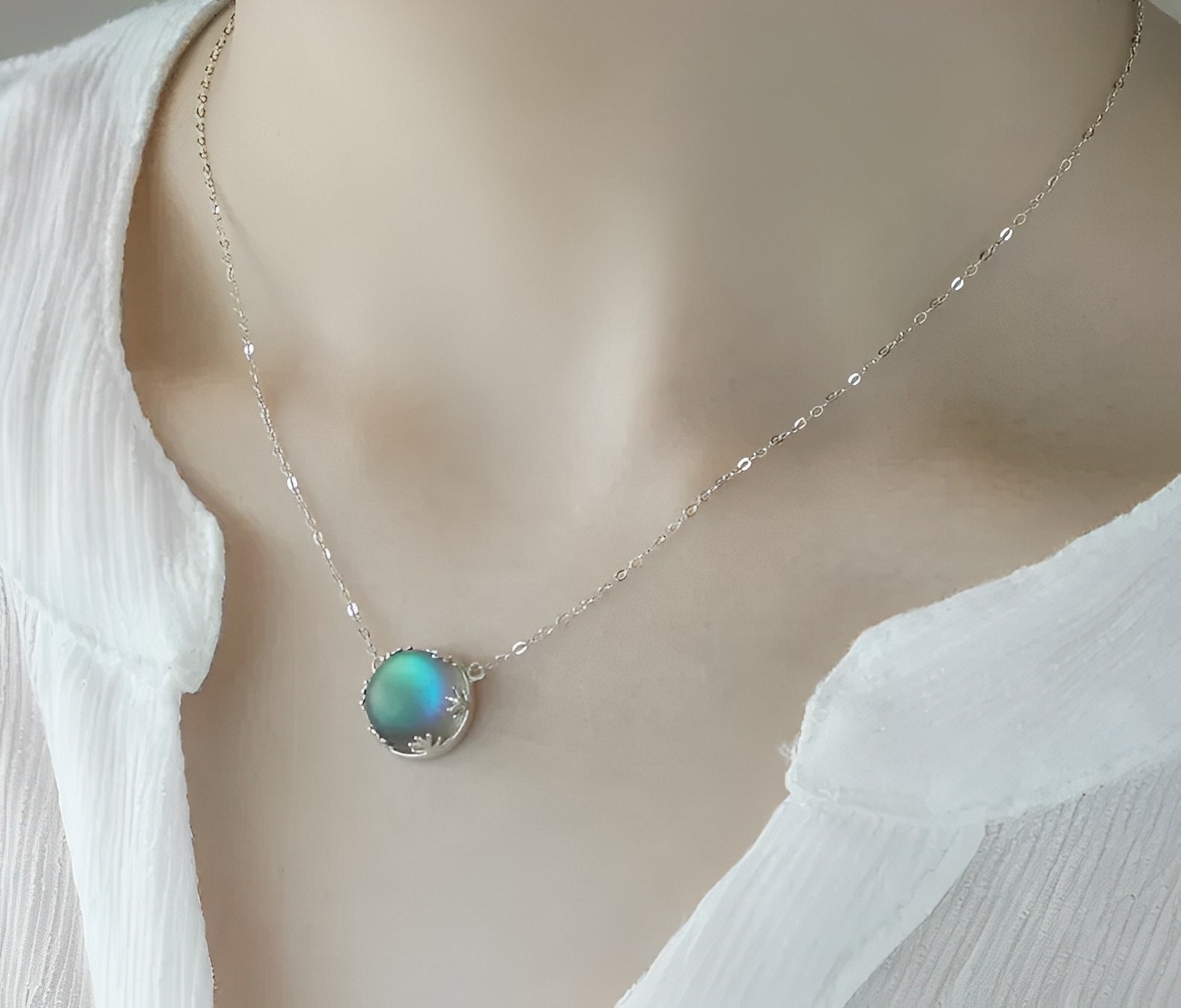
2. Color & Appearance
The color palette of moonstone is diverse, encompassing hues like blue, peach, gray, and white. The stone’s soft glow varies in intensity and quality, based on its adularescence. Opalite, on the other hand, is often milky with iridescent qualities, primarily showcasing blue or pink tones. Its synthetic origin ensures a more consistent color profile.
3. Metaphysical Properties
Moonstone has been revered for ages as a symbol of intuition, equilibrium, and safeguarding. Its ties to lunar energies and feminine essence further amplify its mystique. Despite its man-made origin, opalite too has spiritual connotations. It’s valued for promoting meditation, facilitating communication, and aiding transitions, often acting as a talisman against fatigue.
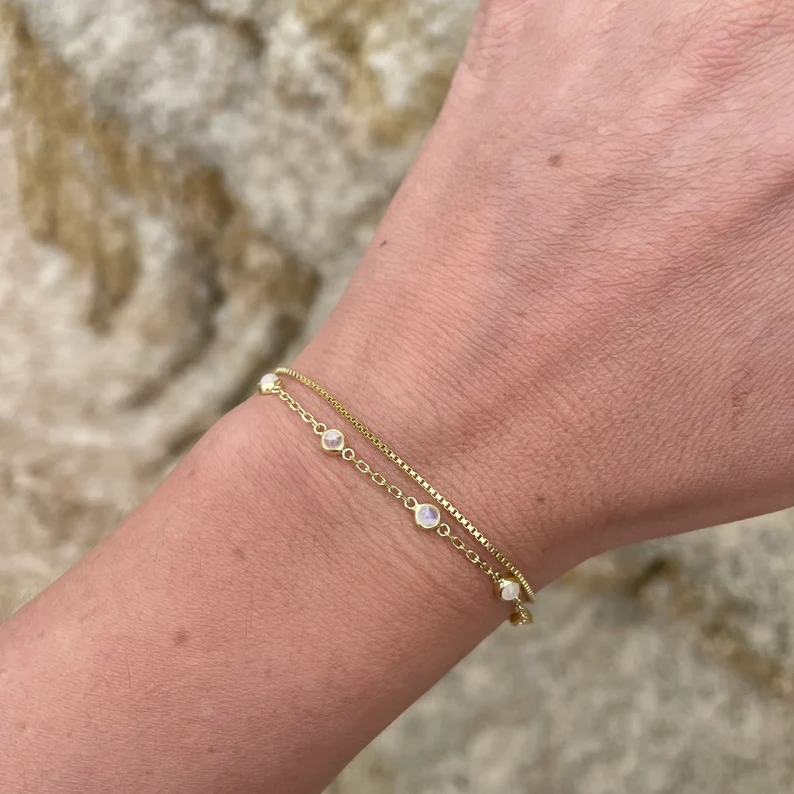
4. Value & Price
The valuation of moonstones pivots on factors such as clarity, hue, dimensions, and adularescence quality. Authentic, pristine moonstones are especially sought after and can fetch premium prices. In contrast, the more accessible opalite, owing to its manufactured nature, is typically more wallet-friendly. Its valuation doesn’t hinge significantly on attributes like purity or adularescence.
5. Durability
Moonstone, with its Mohs hardness scale rating of 6-6.5, isn’t particularly robust. It demands meticulous care to avert scratches or potential damage. Opalite, with its glass or resin base, is equally susceptible to scratches. However, its man-made origin may occasionally lend it enhanced uniformity in durability.
What is Moonstone Meaning and Symbolism?

Moonstone, with its ethereal glow reminiscent of moonlight, has been revered and celebrated throughout various cultures and histories. The stone’s mesmerizing appearance is complemented by a rich tapestry of symbolism and meaning.
1. Femininity and Motherhood
Moonstone is often associated with the moon, which is frequently linked to feminine energy. The stone represents motherhood, fertility, and the nurturing aspect of women. In many cultures, it’s believed to enhance female energies and intuition.
2. Growth and New Beginnings
Just as the moon goes through phases, moonstone is thought to reflect life cycles, growth, and new beginnings. It’s often associated with personal growth, helping wearers understand their destiny and purpose.

3. Emotion and Intuition
The soft luminescence of the moonstone is believed to awaken the intuition and psychic abilities of the wearer. It’s thought to be a guiding light in the dark, aiding clarity of mind and decision-making. It’s also associated with emotional stability and is believed to calm overreactions and emotional triggers.
4. Protection
In ancient times, travelers would carry moonstone as a protective talisman during nighttime journeys. It was believed to shield them from harm. The stone is also considered protective for those at sea.

5. Love and Passion
Moonstone is often linked to love and passion. Its dreamy quality is believed to arouse tender feelings and harmonize the heart with the soul. Some cultures believe that two people wearing moonstones will fall deeply in love during the full moon.
6. Healing and Balance
On a therapeutic level, moonstone is believed to balance hormonal and menstrual cycles for women. It’s also associated with balancing the yin-yang energies and promoting a calm, rejuvenating energy that can help with stress and chaotic situations.
How Do You Clean and Care for Moonstone Jewelry?

Avoid using ultrasonic cleaners or steam cleaners when cleaning moonstone jewelry. Instead, simply use a mild, non-abrasive liquid soap and warm water.
Put a few drops of dishwashing liquid in water and soak the jewelry for 2 to 3 minutes. When you take it out it should be clean. If it’s still dirty, gently wipe it with a wet cloth or use a soft brush. Ensure that you rinse the piece thoroughly and dry it carefully before you store it away.
As we mentioned before, the moonstone is a relatively soft stone (6 – 6.5 Mohs). This means that it is prone to losing its smooth polish due to surface scratches. Substances with a higher hardness ranking, such as diamonds, can scratch and damage a moonstone. Always store your moonstone jewelry separately, in a jewelry box or a fabric pouch.
Another thing to note is that moonstone is very sensitive to high temperatures and should be kept away from excess heat.
How Do You Buy Moonstone Jewelry Online?

Moonstone jewelry can be found in many online stores, mainly because it’s the birthstone for June. Any retailer that offers birthstone jewelry will have moonstones on offer.
When buying online, ensure that you are purchasing from a top-rated vendor with a proven track record. Some vendors offer moonstone authenticity certificates and have a clear and reliable returns policy. Here’s a look at some of the most popular online stores to shop for moonstone jewelry.
1. Angara
Specializing in gemstone jewelry, Angara is an online platform that boasts a diverse range of moonstone pieces. Shoppers can expect both traditional and contemporary designs, catering to various tastes. Check out Angara here.
2. Etsy
A marketplace known for its handcrafted and unique items, Etsy is the place to go for artisanal moonstone jewelry. From delicate moonstone rings to intricate pendants and earrings, the platform offers creations from numerous independent artisans. Etsy is also a treasure trove for vintage moonstone pieces, making it a perfect destination for those seeking something truly one-of-a-kind. Browse Etsy here.
3. Amazon
The global online retail giant, Amazon, offers a vast selection of products, including moonstone jewelry. Shoppers can find both contemporary designs and artisanal moonstone pieces on the platform. Given the platform’s vastness, there’s also an opportunity to stumble upon vintage moonstone jewelry. However, given the diversity of sellers, it’s essential to read reviews and perhaps focus on sellers specializing in jewelry to ensure authenticity and quality. Search Amazon here.
Wrapping Up
Moonstone jewelry encapsulates the ethereal beauty of the moon’s enchanting glow. Its mesmerizing play of colors and deep-rooted symbolism make it a timeless choice for adornment. Whether worn for its believed metaphysical properties or simply appreciated for its unique aesthetic, moonstone jewelry brings a touch of magic and elegance to any collection.



